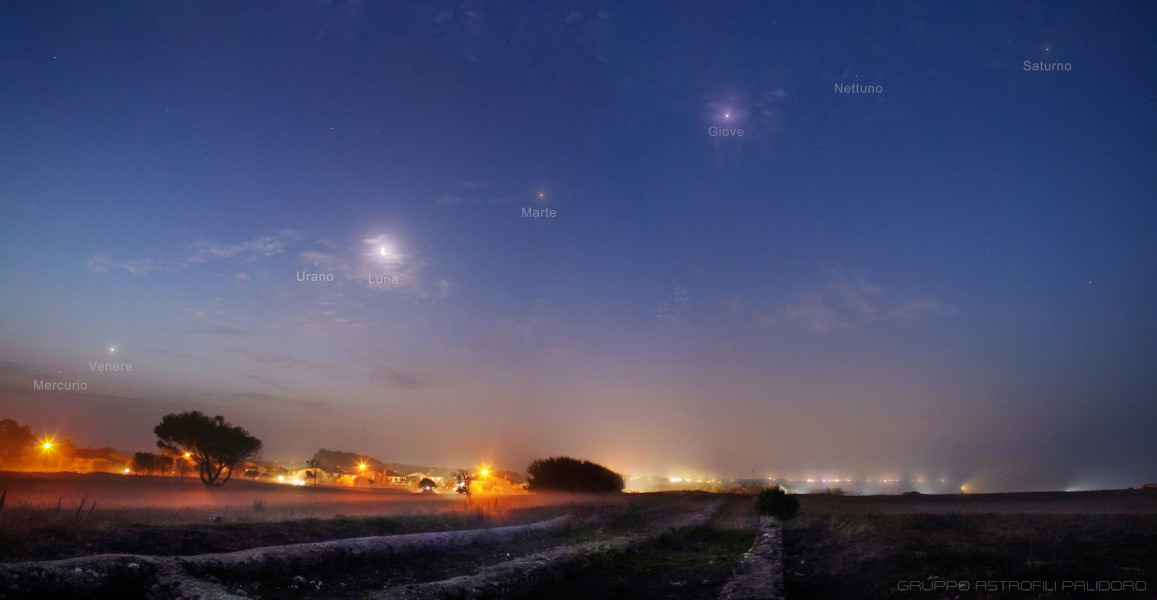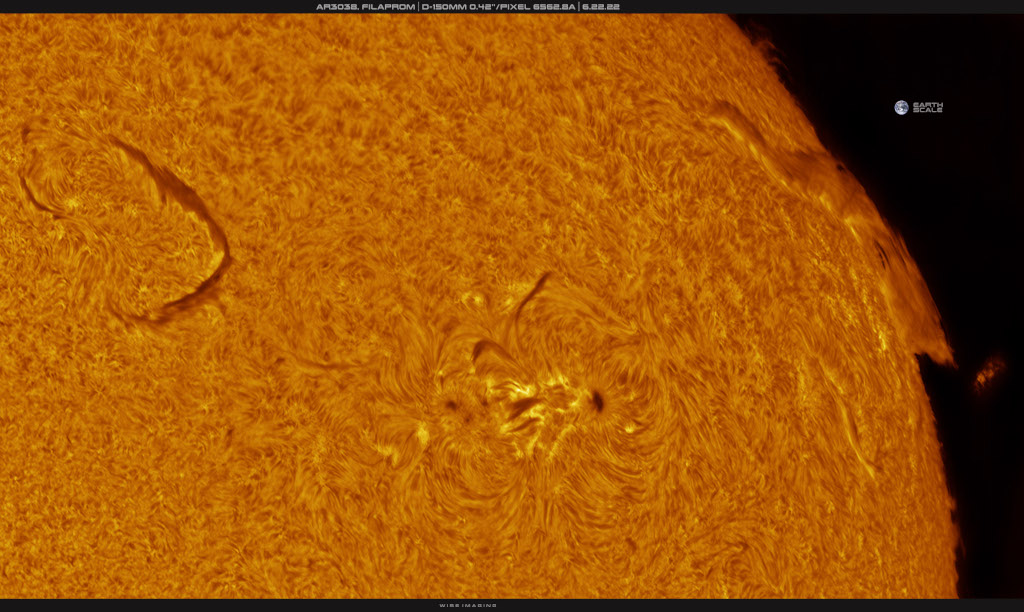Nombre total de pages vues
30/06/2022
MERVEILLEUX MONDE SOUS-MARIN - La flabelline blanche
ASTRONOMY - Solar System Family Portrait
2022 June 30
Image Credit & Copyright: Alexis Trigo
Explanation: Yes, but have you ever seen all of the planets at once? A rare roll-call of planets has been occurring in the morning sky for much of June. The featured fisheye all-sky image, taken a few mornings ago near the town of San Pedro de Atacama in Chile, caught not only the entire planet parade, but the Moon between Mars and Venus. In order, left to right along the ecliptic plane, members of this Solar System family portrait are Earth, Saturn, Neptune, Jupiter, Mars, Uranus, Venus, Mercury, and Earth. To emphasize their locations, Neptune and Uranus have been artificially enhanced. The volcano just below Mercury is Licancabur. In July, Mercury will move into the Sun's glare but reappear a few days later on the evening side. Then, in August, Saturn will drift past the direction opposite the Sun and so become visible at dusk instead of dawn. The next time that all eight planets will be simultaneously visible in the evening sky will be in 2122.
28/06/2022
ASTRONOMY - Mercury from Passing BepiColombo
2022 June 28
Image Credit & License: ESA, JAXA, BepiColombo, MTM
Explanation: Which part of the Moon is this? No part -- because this is the planet Mercury. Mercury's old surface is heavily cratered like that of Earth's Moon. Mercury, while only slightly larger than Luna, is much denser and more massive than any Solar System moon because it is made mostly of iron. In fact, our Earth is the only planet more dense. Because Mercury rotates exactly three times for every two orbits around the Sun, and because Mercury's orbit is so elliptical, visitors on Mercury could see the Sun rise, stop in the sky, go back toward the rising horizon, stop again, and then set quickly over the other horizon. From Earth, Mercury's proximity to the Sun causes it to be visible only for a short time just after sunset or just before sunrise. The featured image was captured last week by ESA and JAXA's passing BepiColombo spacecraft as it sheds energy and prepares to orbit the innermost planet starting in 2025.
26/06/2022
SAUDE/MEDECINA - Estamos muito perto de encontrar uma vacina contra o cancro
Na área do cancro, a chamada medicina de precisão tem sido fundamental na identificação de mutações tumorais que podem ser usadas como alvo de vacinas de mRNA personalizadas. “Durante muitos anos ficámos todos deslumbrados com a possibilidade de identificarmos alterações genéticas nos genes do cancro, mas agora já estamos a perceber que existem também muitas alterações no RNA [ácido ribonucleico, molécula essencial na síntese de proteínas] e no metabolismo de pequenas moléculas”, comenta Maria do Carmo Fonseca, cientista galardoada com o Prémio Pessoa em 2010, atualmente presidente da RNA Society.
“Da mesma maneira que, na Covid-19, injetamos o mRNA que codifica a proteína Spike, numa vacina contra o cancro temos de incluir a informação genética que codifica as proteínas próprias das células cancerosas e que são especificas daquele cancro”, explica a investigadora. No entanto, ao contrário do SARS-CoV-2, em que a proteína Spike é igual para todos os doentes, no cancro cada caso é um caso e a vacina tem de ser muito personalizada.
Testadas sobretudo em pacientes com melanoma, na Alemanha e nos Estados Unidos da América, as vacinas já foram administradas a “centenas de doentes” no âmbito de ensaios clinicos, “com resultados muito promissores”, assegura Carmo Fonseca.
Em Portugal, a cientista conduz uma investigação revolucionária que, no futuro, poderá criar uma vacina de mRNA capaz de “ensinar o nosso sistema imune a reconhecer as células cancerosas, assim que elas aparecem no corpo, e a destruí-las imediatamente”. Esta vacina vai ser específica para cancros hereditários resultantes de mutação BRCA e, neste momento, os investigadores estão focados na mutação fundadora portuguesa, que é a mais frequente em Portugal.
Os mais importantes avanços da Ciência na área do cancro – seja na prevenção, como no caso das vacinas, seja no diagnóstico (em que a Inteligência Artificial começa a dar cartas) e, principalmente, no tratamento (com as novas terapias celulares a ensinarem o nosso corpo a adquirir uma “superimunidade”) – são longamente esmiuçados num artigo da VISÃO Saúde .
Nada disto é ficção científica – a tecnologia está aí e, em muitos casos, consegue mesmo salvar-nos.
Visão
ASTRONOMY - Light Echoes from V838 Mon
2022 June 26
Image Credit: NASA, ESA, H. E. Bond (STScI)
Explanation: What caused this outburst of V838 Mon? For reasons unknown, star V838 Mon's outer surface suddenly greatly expanded with the result that it became one of the brighter stars in the Milky Way Galaxy in early 2002. Then, just as suddenly, it shrunk and faded. A stellar flash like this had never been seen before -- supernovas and novas expel matter out into space. Although the V838 Mon flash appears to expel material into space, what is seen in the featured image from the Hubble Space Telescope is actually an outwardly expanding light echo of the original flash. In a light echo, light from the flash is reflected by successively more distant surfaces in the complex array of ambient interstellar dust that already surrounded the star. V838 Mon lies about 20,000 light years away toward the constellation of the unicorn (Monoceros), while the light echo above spans about six light years in diameter.
OVNI - Espirais de luz azul no céu da Nova Zelândia
Eram 19h25 de domingo quando Alasdair Burns, guia de observação de estrelas na Ilha Stewart, Nova Zelândia, recebeu uma mensagem de um amigo a pedir que fosse olhar para o céu. Burns saiu de casa e testemunhou uma enorme espiral azul de luz no meio da escuridão do céu. “Parecia uma enorme galáxia em espiral, ali a pairar no céu e a atravessá-lo lentamente. Foi uma sensação muito estranha”, confessa, citado pelo The Guardian.
Depois de ter observado o fenómeno durante uns segundos, rapidamente se lembrou de eternizar o momento e capturou algumas imagens.
Richard Easther, físico na Universidade de Auckland, explicou ao jornal que são formadas nuvens desta natureza quando um foguetão leva um satélite para a órbita da terra. “Quando o combustível propulsor é ejetado, o que temos essencialmente é água e dióxido de carbono, que formam uma nuvem iluminada pelo sol”, começa por explicar.
“A combinação da geometria da trajetória da órbita do satélite e da forma como nós estamos posicionados em relação ao Sol foi o que foi capaz de produzir estas nuvens esquisitas que eram visíveis da Ilha Sul”, acrescenta o físico.
O “espetáculo” observado terá sido provocado pelo lançamento do satélite da Globalstar a cargo da SpaceX, que foi enviado para uma órbita mais baixa a partir do Cabo Canaveral, na Flórida.
Visão
25/06/2022
ASTRONOMY - Planets of the Solar System
2022 June 25
Image Credit & Copyright: Antonio Canaveras, Chiara Tronci, Giovanni Esposito, Giuseppe Conzo, Luciana Guariglia, (Gruppo Astrofili Palidoro)
Explanation: Simultaneous images from four cameras were combined to construct this atmospheric predawn skyscape. The cooperative astro-panorama captures all the planets of the Solar System, just before sunrise on June 24. That foggy morning found innermost planet Mercury close to the horizon but just visible against the twilight, below and left of brilliant Venus. Along with the waning crescent Moon, the other bright naked-eye planets, Mars, Jupiter, and Saturn lie near the ecliptic, arcing up and to the right across the wide field of view. Binoculars would have been required to spot the much fainter planets Uranus and Neptune, though they also were along the ecliptic in the sky. In the foreground are excavations at an ancient Roman villa near Marina di San Nicola, Italy, planet Earth.
24/06/2022
ASTRONOMY - Filaprom on the Western Limb
2022 June 24
Image Credit & Copyright: Martin Wise
Explanation: A solar filament is an enormous stream of incandescent plasma suspended above the active surface of the Sun by looping magnetic fields. Seen against the solar disk it looks dark only because it's a little cooler, and so slightly dimmer, than the solar photosphere. Suspended above the solar limb the same structure looks bright when viewed against the blackness of space and is called a solar prominence. A filaprom would be both of course, a stream of magnetized plasma that crosses in front of the solar disk and extends beyond the Sun's edge. In this hydrogen-alpha close-up of the Sun captured on June 22, active region AR3038 is near the center of the frame. Active region AR3032 is seen at the far right, close to the Sun's western limb. As AR3032 is carried by rotation toward the Sun's visible edge, what was once a giant filament above it is now partly seen as a prominence, How big is AR3032's filaprom? For scale planet Earth is shown near the top right corner.
23/06/2022
MERVEILLEUX MONDE SOUS-MARIN - Le dugon
METEO EXTREME - L’éclair le plus long
LES BELLES INVENTIONS DE LEONARD DE VINCI - Ses machines volantes
Voici une des machines volantes de Léonard de Vinci . Elle semble plus tenir du planeur que des inventions dessinées pour faire du vol batt...

-
2022 September 26 All the Water on Planet Earth Illustration Credit: Jack Cook, Adam Nieman, Woods Hole Oceanographic Institution ; Data ...
-
2025 May 11 The Surface of Venus from Venera 14 Image Credit: Soviet Planetary Exploration Program , Venera 14 ; Processing & Copyri...









